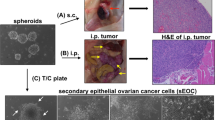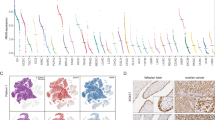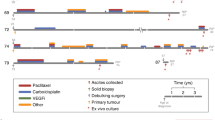Abstract
We have previously shown that the low molecular weight (LMW) forms (trunk 1 and trunk 2) of cyclin E are biochemically hyperactive and induce G1/S progression in normal epithelial cells. Here we investigate the biologic consequences of LMW cyclin E expression in ovarian cancer cells. Using a panel of ovarian carcinoma tumors we find that cyclin E overexpression is invariably due to the presence of LMW forms and that expression of these forms appears to correlate with more advanced grade and stage of disease. Despite similar expression of p21 and p27, cyclin E overexpressing tumors have higher kinase function. Using an isogenic ovarian cancer model, we find that clones that overexpress the trunk 1 (T1) protein have a 10-fold increase in cyclin E kinase function, a 20% increase in S-phase fraction, a 10–15% decrease in doubling time and a 20% increase in colony formation compared to parental cells that express only the FL cyclin E protein. T1 clones were resistant to G1 arrest but more sensitive to cisplatin. Therefore, in ovarian tumors, the presence of LMW cyclin E forms confers altered biologic properties. Our data provides a potential mechanism for the poor prognosis of patients with LMW cyclin E expressing tumors.
This is a preview of subscription content, access via your institution
Access options
Subscribe to this journal
Receive 50 print issues and online access
$259.00 per year
only $5.18 per issue
Buy this article
- Purchase on Springer Link
- Instant access to full article PDF
Prices may be subject to local taxes which are calculated during checkout






Similar content being viewed by others
References
Akli S and Keyomarsi K . (2003). Cancer Biol. Ther., 2, 16–25.
Buckley MF, Sweeney KJ, Hamilton JA, Sini RL, Manning DL, Nicholson RI, deFazio A, Watts CK, Musgrove EA and Sutherland RL . (1993). Oncogene, 8, 2127–2133.
Cappella P, Tomasoni D, Faretta M, Lupi M, Montalenti F, Viale F, Banzato F, D'Incalci M and Ubezio P . (2001). Int. J. Cancer, 93, 401–408.
Chen X, Lowe M and Keyomarsi K . (1999). Oncogene, 18, 5691–5702.
Del Pizzo JJ, Borkowski A, Jacobs SC and Kyprianou N . (1999). Am. J. Pathol., 155, 1129–1136.
Farley J, Smith LM, Darcy KM, Sobel E, O'Connor D, Henderson B, Morrison LE and Birrer MJ . (2003). Cancer Res., 63, 1235–1241.
Fukuse T, Hirata T, Naiki H, Hitomi S and Wada H . (2000). Cancer Res., 60, 242–244.
Gray-Bablin J, Rao S and Keyomarsi K . (1997). Cancer Res., 57, 604–609.
Harwell R, Porter D, Danes C and Keyomarsi K . (2000). Cancer Res., 60, 481–489.
Itamochi H, Kigawa J, Akeshima R, Sato S, Kamazawa S, Takahashi M, Kanamori Y, Suzuki M, Ohwada M and Terakawa N . (2002). Oncology, 62, 349–353.
Jang SJ, Park YW, Park MH, Lee JD, Lee YY, Jung TJ, Kim IS, Choi IY, Ki M, Choi BY and Ahn MJ . (1999). Eur. J. Surg. Oncol., 25, 157–163.
Johnson KR, Wang L, Miller III MC, Willingham MC and Fan W . (1997). Clin. Cancer Res., 3, 1739–1745.
Keyomarsi K, Conte D, Toyofuku W and Fox M . (1995). Oncogene, 11, 941–950.
Keyomarsi K and Herliczek T . (1997). Progress in Cell Cycle Research, Vol. 3, Meijer L, Guidet S and Philippe M (eds). Plenum Press: New York, pp. 171–191.
Keyomarsi K, O'Leary N, Molnar G, Lees E, Fingert H and Pardee A . (1994). Cancer Res., 54, 380–385.
Keyomarsi K and Pardee A . (1993). Proc. Natl. Acad. Sci. USA, 90, 1112–1116.
Keyomarsi K, Tucker S, Buchholz T, Lawrence C, Ding Y, Hortobagyi G, Bedrosian I, Knickerbucker C, Toyofuku W, Lowe M, Herliczek T and Bacus S . (2002). N. Engl. J. Med., 347, 1566–1575.
Koff A, Cross F, Fisher A, Schumacher J, Leguellec K, Philippe M and Roberts JM . (1991). Cell, 66, 1217–1228.
Kolfschoten GM, Hulscher TM, Pinedo HM and Boven E . (2000). Br. J. Cancer, 83, 921–927.
Lew DJ, Dulic V and Reed SI . (1991). Cell, 66, 1197–1206.
Mishina T, Dosaka-Akita H, Hommura F, Nishi M, Kojima T, Ogura S, Shimizu M, Katoh H and Kawakami Y . (2000). Clin. Cancer Res., 6, 11–16.
Muller-Tidow C, Metzger R, Kugler K, Diederichs S, Idos G, Thomas M, Dockhorn-Dworniczak B, Schneider PM, Koeffler HP, Berdel WE and Serve H . (2001). Cancer Res., 61, 647–653.
Pardee AB . (1989). Science, 246, 603–608.
Pestell KE, Hobbs SM, Titley JC, Kelland LR and Walton MI . (2000). Mol. Pharmacol., 57, 503–511.
Porter D, Zhang N, Danes C, McGrehan M, Harwell R, Farouk S and Keyomarsi K . (2001). Mol. Cell. Biol., 21, 6254–6269.
Rao S, Lowe M, Herliczek T and Keyomarsi K . (1998). Oncogene, 17, 2393–2402.
Rao S, Porter D, Chen X, Herliczek T, Lowe M and Keyomarsi K . (1999). Proc. Natl. Acad. Sci. USA, 96, 7797–7802.
Sangfelt O, Erickson S, Castro J, Heiden T, Gustafsson A, Einhorn S and Grander D . (1999). Oncogene, 18, 2798–2810.
Sherr C . (1996). Science, 274, 1672–1677.
Sherr CJ . (1993). Cell, 73, 1059–1065.
Smith ML and Seo YR . (2000). Anticancer Res., 20, 2537–2539.
Sui L, Dong Y, Ohno M, Sugimoto K, Tai Y, Hando T and Tokuda M . (2001). Gynecol. Oncol., 83, 56–63.
Wang X, Rosales J, Magliocco A, Gnanakumar R and Lee K . (2003). Oncogene, 22, 769–774.
Weinberg RA . (1995). Cell, 81, 323–330.
Wingate H, Bedrosian I, Akli S and Keyomarsi K . (2003). Cell Cycle, 2, 461–466.
Acknowledgements
The authors wish to thank Dr. Robert Bast for critical discussions during the course of this project. IB is supported by a fellowship (T32-CA09599-14) from the NIH/NCI. This work was supported in part by grant (DAMD17-03-1-0259) from the US Army Medical Research and Material Command, and grant (R01-CA87548) from the National Cancer Institute (both to KK).
Author information
Authors and Affiliations
Corresponding author
Rights and permissions
About this article
Cite this article
Bedrosian, I., Lu, K., Verschraegen, C. et al. Cyclin E deregulation alters the biologic properties of ovarian cancer cells. Oncogene 23, 2648–2657 (2004). https://doi.org/10.1038/sj.onc.1207408
Received:
Revised:
Accepted:
Published:
Issue Date:
DOI: https://doi.org/10.1038/sj.onc.1207408
Keywords
This article is cited by
-
Cyclins and cyclin-dependent kinases: from biology to tumorigenesis and therapeutic opportunities
Journal of Cancer Research and Clinical Oncology (2023)
-
CCNE1 copy-number gain and overexpression identify ovarian clear cell carcinoma with a poor prognosis
Modern Pathology (2017)
-
PKCiota promotes ovarian tumor progression through deregulation of cyclin E
Oncogene (2016)
-
Rab14 is overexpressed in ovarian cancers and promotes ovarian cancer proliferation through Wnt pathway
Tumor Biology (2016)
-
A phase 1 study with dose expansion of the CDK inhibitor dinaciclib (SCH 727965) in combination with epirubicin in patients with metastatic triple negative breast cancer
Investigational New Drugs (2015)



